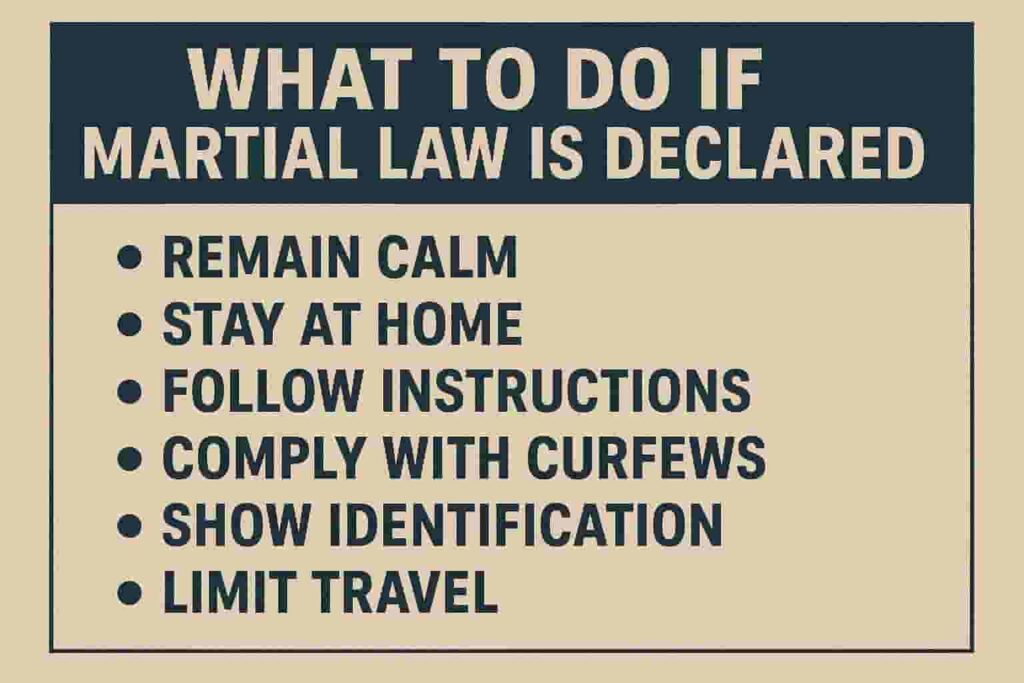When martial law is declared, the military temporarily takes over some functions of civilian government to restore order. Daily life can change fast: curfews, checkpoints, travel limits, and stricter enforcement. Your job is simple but serious—stay safe, stay lawful, and keep your household functional until normal governance resumes. Here’s a clear plan.
1) Get reliable confirmation, fast
Don’t act on rumors. Confirm the declaration and the rules that apply to your exact location through official channels: government websites, verified social media accounts, TV and radio, the emergency alert system, and local authorities. Screenshot or save the notice, including dates, hours (curfew times), the area covered, and any exemptions (medical, essential workers). This prevents accidental violations.
2) Understand the local rules and the boundaries
Martial-law orders usually spell out what changes: movement restrictions, ID requirements, gathering limits, and any special permits or travel corridors. Learn the details that affect you—what time curfew starts, which roads are open, what documentation you must carry. Rules can differ by neighborhood or district, and they can change quickly. Re-check every 12–24 hours.
3) Prioritize safety and lawful compliance
Complying with lawful orders protects you and others. If stopped at a checkpoint, keep hands visible, follow instructions, and speak calmly. Carry a government ID, proof of address, essential medical info, and, if relevant, a letter from your employer identifying you as an essential worker. Do not film in restricted areas or interfere with operations. If you believe an order is unlawful, do not argue on the spot; document the details and seek legal help later.
4) Stabilize your household for two weeks
Aim to reduce trips and reliance on disrupted services. Keep it simple: enough shelf-stable food, safe drinking water, a way to cook without power, basic first aid, prescription refills, infant supplies if needed, and hygiene items. Stock what you actually use; don’t hoard or panic-buy. If you have medical devices, ensure backup power or relocation plans. Pets need food, meds, and ID tags as well.
5) Make documents and cash accessible
Store originals or copies of IDs, health cards, prescriptions, insurance, property records, and emergency contacts in a waterproof folder. Back them up digitally (encrypted) and share with a trusted relative. Keep some small-denomination cash—ATMs and card systems may be unreliable.
6) Plan your movements—then minimize them
If you must travel, plan the route before leaving, choose daylight hours, and build extra time for checkpoints. Wear practical clothing, carry only what you need, and keep your phone charged. If you rely on caregivers or you are one, coordinate written permission or care schedules that match curfew windows.
7) Communicate smartly and verify everything
Set a family check-in schedule and a fallback meeting point if phones die. Misinformation spreads fast during crises; treat unverified claims as hazards. Follow official channels and one or two reputable local newsrooms rather than bouncing between dozens of feeds. If the internet is throttled or cut, turn to radio and community notice points.
8) Look after vulnerable people nearby
Check in on seniors, people with disabilities, and families with infants in your building or street. Share accurate updates and help them arrange rides to medical appointments within permitted hours. Small, local cooperation lowers risk for everyone.
9) If you’re approached, searched, or detained
Stay calm. Ask whether you are free to leave; if not, you are being detained. Provide ID when lawfully required. You can politely ask for the reason for the stop or detention and the name or unit of the officer. Do not physically resist. If you believe your rights were violated, note the time, place, unit markings, names if visible, and any witnesses. Preserve this record and seek legal counsel when you are safe to do so. The field is not the forum for legal debates.
10) Work, school, and daily obligations
Expect schedules to shift. Employers may issue letters confirming essential status; keep a photo of the letter on your phone and a paper copy. Schools may move to remote instruction or temporary closure—save notices and track assignment deadlines. If you’re caring for someone, ask healthcare providers for written appointment confirmations to show at checkpoints.
11) Keep your digital footprint cautious and purposeful
Posting live locations, troop movements, or checkpoint layouts can endanger people and may violate orders. Share safety information, not operational details. Back up your phone, use strong PINs, and enable offline access to crucial documents and maps.
12) After the emergency begins to ease
As curfews relax and services resume, keep your receipts, photos, and notes—these help with insurance claims, employment issues, or formal complaints. Participate in any official review or public hearings. Emergencies end faster when communities give clear, documented feedback about what worked and what didn’t.
Common mistakes to avoid
Acting on rumors, leaving home without ID, ignoring curfew because “the streets look quiet,” broadcasting sensitive details online, hoarding supplies you won’t use, getting into confrontations with officials, and assuming yesterday’s rules still apply today. Treat the situation as dynamic and update your plan accordingly.
Bottom line
Martial law is designed to be temporary. Your best strategy is calm, lawful cooperation paired with practical self-reliance: confirm the rules, limit travel, keep essentials on hand, maintain steady communication, and document what matters. That combination keeps you and your community safer while institutions return to normal.
Also read:




